

(excerpts from the "Overview of Road-Related Budget for Fiscal 2002")
- Increase the number of tollgates providing Electronic Toll Collection (ETC) service: introduce ETC service at approximately 900 tollgates, corresponding to approximately 90% of the total traffic volume
- Introduce prepayment discounts and ETC-dedicated lanes aimed at promoting the widespread use of ETC service
- Implement "Smart Cruise" System proving tests on the New Meishin Expressway (in Mie Prefecture), etc.
- Provide spaces to accommodate fiber-optic cables for road management use: install approximately 1,200 km of new spaces to cover approximately 50% of all communities nationwide
- Open up fiber-optic cables for road management use to the private sector, etc.
(1) The introduction of various ITS services will be promoted to help create safer and more comfortable transport through information technologies that enable communication among human beings, vehicles and roads.
- Create a cumulative economic impact of approximately 60 trillion yen in ITS information and communications related markets by 2015 and create jobs for approximately 1.07 million people (Reference: February 1999 Report by the Telecommunications Technology Council)
(2) To promote the widespread use of ETC*2 , the number of tollgates that offer ETC service will be increased. Limited-time special ETC discounts*3 and ETC-dedicated lanes*4 will continue to be promoted, and prepayment discounts will also be introduced.
| Goal | Introduce ETC at approximately 900 tollgates by the end of FY 2002 -> By the end of FY 2002, ETC service is expected to be introduced at approximately 900 tollgates, corresponding to approximately 90% of the total traffic volume (goal expected to be achieved) |
- Increase the number of tollgates offering ETC service: to be introduced at all tollgates on the Metropolitan Expressway and Hanshin Expressway and on the No. 2 Tomei/Meishin Expressway, etc.
- Economic impact of the use of ETC technologies: Cumulative total of approximately 12 trillion yen by 2015 (Reference: February 1999 Report by the Telecommunications Technology Council)
(3) Proving tests for Smart CruiseSystems - designed to reduce the number of traffic accidents by providing information on unnoticed obstacles around curves and so on to the on-board car navigation equipment - will be promoted, with the aim of pioneering the introduction of such systems by FY2003
- Smart CruiseSystems proving tests: To be conducted at New Meishin Expressway (Mie Prefecture), etc.
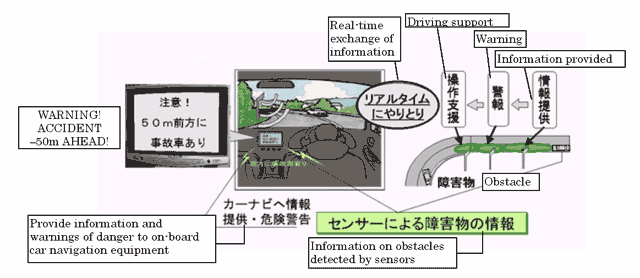
(4) The introduction of various services using ITS technologies will be promoted in order to help create a livable environment, and proving tests will be conducted for new services.
- Promote projects for developing ITS-related facilities *5 and other ITS projects: project budget 71.7 billion yen
(Road information collection equipment, information providing systems at "Michi-no-Eki" [roadside rest stations], systems for providing information on parking availability, etc.)
- Research & development of pedestrian ITS (designed to provide information to help make pedestrian transport safe and comfortable)
- Proving tests for new ITS services
- Provide information on bus arrival times via the Internet: Nagoya City, Sendai City, etc.
- Support for more efficient waste collection and more appropriate waste disposal: Tokyo City
- Reduce snow removal time and increase operational efficiency by means of driving assistance: National Highway Route 8 (Niigata Prefecture) etc.
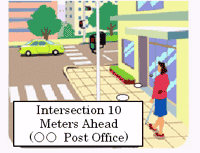
(5) VICS *6 information and information on road surface conditions, roadwork and so on, as well as information on public transport, "barrier-free" facilities and so on, will be upgraded in order to ensure smooth and pleasant transport in time for the World Cup in Japan.
- VICS information service: expand nationwide
- Information service via the Internet, mobile phones, etc.: Hokkaido, etc.
(1) To deal with road problems quickly and decisively, the construction of "Information Boxes" housing fiber-optic cables that are linked to closed circuit television (CCTV *7) and other equipment will be promoted.
To assist the rapid construction of a private sector fiber-optic network that will enable the high-speed transmission of large quantities of data at low cost, the construction of joint fiber-optic cable and telephone line ducts, etc. will be promoted to create a network of spaces to accommodate fiber-optic cables, and the opening up of these "Information Boxes" to the private sector will be promoted.
In addition, fiber-optic cables for road management use will also be opened up to first-tier telecommunications companies and other private sector companies. In addition, complete details of the status of the construction of spaces to accommodate road and other public fiber-optic cables and so on will be provided via the Internet.
| Goal | Increase the proportion of communities equipped with spaces to accommodate fiber-optic cables in the 5-year Plan (1998 - 2002) from approximately 10% to approximately 50% -> Approximately 50% will be covered by the end of FY 2002 (goal expected to be achieved) |
- Construction of spaces to accommodate road fiber-optic cables: project budget 297 billion yen
Information boxes, etc. provided for a distance of approximately 1,200 km along National Highway Route 6 between the cities of Iwaki (Fukushima Prefecture) and Iwanuma (Miyagi Prefecture)
- Private sector utilization of space to accommodate road fiber-optic cables: total approximately 10,700 km (of which, Information Boxes accounts for 8,800km)
- Future intended usage (including the above mentioned spaces): total approximately 60,000 km (as of the end of November 2001)
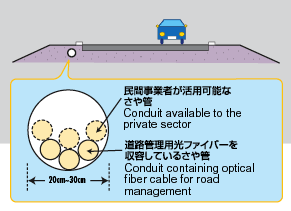
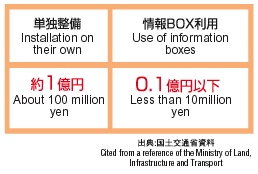
(2) In order to improve the disaster prevention capabilities of the region through the sharing of disaster information, fiber-optic cables for road management use, fiber-optic cables for river management use and prefectural and municipal government offices, etc. will be interconnected
(3) To help create an information infrastructure for society, digital data for Road GIS will be prepared, and Road reference points *8 will be installed on a trial basis. In addition, road information such as information on road construction, traffic restrictions, snowfall and the like will be provided publicly to meet the high demands.
- Construction of Road GIS: project budget 7 billion yen
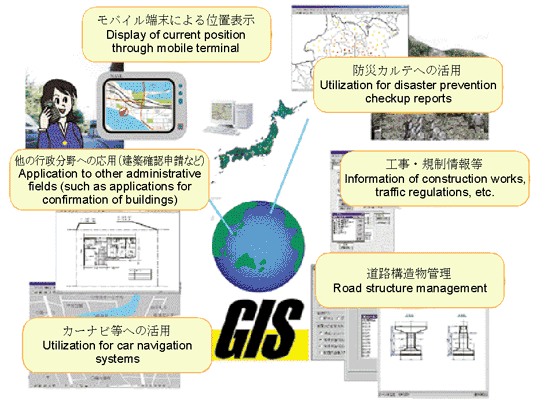
1. ITS: Abbreviation for Intelligent Transport System.
2. ETC: Abbreviation for Electronic Toll Collection. A system enabling drivers to pay the tolls on toll roads without having to stop.
3. Special limited time discount for ETC: a 20% discount on expressway tolls for ETC users, up to a maximum amount of 10,000 yen per public highway corporation. The deadline for applications is the end of June 2002, and the discount will be in effect until the end of June 2004.
4. ETC-dedicated lanes: Lanes open to only ETC user vehicles. These will be provided in sequence starting from the tollgates at which smooth transport is possible under normal traffic conditions, where they will provide maximum benefit. As of December 2001, ETC-only lanes had been provided in 450 locations.
5. Projects for developing ITS-related facilities: Projects designed to assist local public organizations in laying fiber-optic cables and constructing other ITS-related facilities on national highways, prefectural/municipal roads, etc. as part of road renovation work and the like.
6. VICS: Abbreviation for Vehicle Information and Communication System. A system that provides information on traffic congestion and other road traffic information to vehicle on-board equipment in real time.
7. CCTV: Abbreviation for closed circuit television. CCTV cameras are installed to enable information on road surface conditions, the interior of tunnels and so on to be obtained quickly. The term may also refer to the equipment used to transmit and display the images from CCTV cameras.
8. Road reference point: Road reference points, installed on roads, are assigned with latitude and longitude information to match their actual location to the location on a digital map. In addition to their function as kilometer-post, they collect and provide information with equipments such as various sensors.
|
| |
All Rights Reserved, Copyright © 2004 Ministry of Land, Infrastructure, Transport and Tourism |